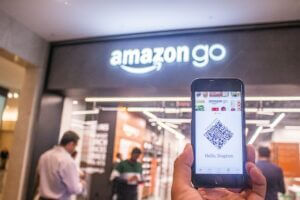[vc_row][vc_column][vc_column_text]
How did stand-alone stores come into being?
Consumers are looking for fast, efficient shopping, especially for food products. Amazon has stepped into the breach, and in 2018 launched the first autonomous store: with no checkouts and no employees.
[/vc_column_text][vc_column_text]
The origins of stand-alone stores
Stand-alone stores are smaller, more focused retail establishments equipped with advanced technologies. Compared with supermarkets, stand-alone stores are generally smaller in size, focusing on specific market segments such as food, health and beauty products, or electronics. They use advanced technologies such as sensors, cameras, computer vision systems and artificial intelligence algorithms to operate autonomously, without the need for human cashiers or sales staff. What's more, they often offer a simplified and rapid shopping experience. Customers can enter the store, pick up the products they need and leave without having to go through a traditional checkout.
[/vc_column_text][vc_column_text css=”.vc_custom_1688030224049{padding-top: 15px !important;padding-right: 30px !important;padding-bottom: 15px !important;padding-left: 30px !important;background-color: #efefef !important;}”]
Case study :
 On January 22, 2018, Amazon opened its first autonomous store in Seattle, named Amazon Go. The concept is "simple": upon entering, customers scan their app. Cameras, sensors and a combination of artificial intelligence then take over to track the customer's journey throughout the store. The customer leaves the store and is debited directly via the Amazon application. Simple in theory, but far more complex in practice, so complex that the brand was delayed by a year.
On January 22, 2018, Amazon opened its first autonomous store in Seattle, named Amazon Go. The concept is "simple": upon entering, customers scan their app. Cameras, sensors and a combination of artificial intelligence then take over to track the customer's journey throughout the store. The customer leaves the store and is debited directly via the Amazon application. Simple in theory, but far more complex in practice, so complex that the brand was delayed by a year.
Amazon calls this technologyJust Walk out". Initial customer feedback has shown it to be disconcertingly easy to use, and above all, it solves a number of problems we've all experienced when shopping, thanks to its 24-hour opening and the elimination of checkout queues. Today, Amazon has 25 stand-alone supermarkets in the USA and 20 in the UK.
[/vc_column_text][vc_column_text]
Leading French retailers such as Auchan (under the name Auchan Go), Monoprix (under the name Black Box), Intermarché and Leclerc have invested in stand-alone stores. But it's the start-ups that are investing even more, innovating their concepts and developing them in different industries, such as textiles.
[/vc_column_text][/vc_column][/vc_row][vc_row][vc_column][vc_column_text]
|
More and more French start-ups interested in autonomous stores |
French start-ups |
|
Ximiti French start-up for giant vending machines. Customers place their orders via their app or directly at the kiosk. A shuttle system picks up the products, and all the customer has to do is pick them up. |
|
|
Boxy French start-up specializing in self-contained stores that hold 250 everyday items in a container. Its aim is to be located in rural areas where there are few stores. |
|
|
KOMET Story: The French start-up offers a turnkey solution for ready-to-wear brands: a fully automated, secure, ultra-connected and mobile physical showroom based on an experiential marketing concept: "TRY, TEST & GO". |
[/vc_column_text][/vc_column][/vc_row][vc_row][vc_column][vc_column_text]
Logistics management for stand-alone stores
Logistics contributes to the overall optimization of self-storage operations. It uses data and analysis to identify opportunities for improvement, reduce costs, optimize workflows and maximize operational efficiency. It seeks to improve processes, reduce delivery times, minimize errors and deliver an optimal customer experience. To make these stores more autonomous, brands manage several aspects: transport, stock and data.
- Inventory management: autonomous stores use automated tracking and inventory management systems to monitor inventory levels in real time. Sensors and object recognition techniques identify missing or out-of-stock products, automatically triggering replenishment orders.
- Stock procurement: Logistics is responsible for stock procurement for the stand-alone warehouse. This involves managing supplier orders, planning deliveries and coordinating receiving operations. Logistics ensures that the store has the products it needs to meet customer demand. The software ensures that stock levels are optimally maintained.
- Receiving and unloading goods: goods are delivered to independent stores either by external suppliers or by central warehouses. Autonomous logistics systems use robots (or drones) to unload goods from delivery trucks and direct them to the appropriate storage areas.
- Sales space organization: in general, small stand-alone stores aim to maximize available space. Independent logistics systems help to organize products efficiently and make aisles accessible to customers. Visual recognition techniques enable product movements to be tracked and correctly repositioned as they are carried by customers.
- Order and payment management: when a customer selects items in an autonomous store, sensors and cameras track the chosen products. Once the customer has finished shopping, autonomous logistics systems automatically generate an invoice and facilitate payment. This can be done via contactless payment methods or mobile applications.
- Data analysis: autonomous stores collect a vast amount of data on customer buying habits, stock levels, product performance and so on. Autonomous logistics systems use data analysis algorithms to provide valuable information on customer preferences, operational efficiency and other key factors. This information can then be used to optimize store operations and enhance the customer experience.
- Maintenance and repair: autonomous warehouses require regular maintenance to ensure the smooth operation of technological equipment. Autonomous logistics systems monitor the status of sensors, cameras, robots and other essential components, and trigger alerts in the event of malfunctions. Technical teams then intervene to carry out the necessary repairs.
[/vc_column_text][/vc_column][/vc_row][vc_row][vc_column][vc_column_text]
The benefits for retailers?
Autonomous stores offer a seamless, frictionless shopping experience. Customers can enter the store, pick up the items they need and leave without going through the checkout or avoiding queues. This saves time and increases customer satisfaction.
What's more, they can remain open 24 hours a day, 7 days a week, without the need for additional staff to watch over the store. This gives customers greater flexibility to shop at their convenience. This gives customers greater flexibility to shop at their convenience. This is particularly advantageous for people with busy work schedules.
Sensors and cameras collect data on customer behavior, such as the products they choose or the time they spend in the store. This data can be used to improve the customer experience, personalize offers and optimize store layout.
The most responsible retailers are able to design their stores to reduce their carbon footprint. For example, they can use energy-efficient lighting systems, optimize space utilization and reduce food waste through precise tracking techniques. What's more, autonomous stores are a test bed for retailers and technology companies. They can test new technologies, innovative retail strategies and emerging business models. This encourages innovation and explores new ways of serving customers.
In an omnichannel context, stand-alone stores can coexist with traditional stores and other sales channels, such as e-commerce, as part of a Omnichannel approach.
By combining the benefits of stand-alone stores with other sales channels, such as e-commerce sites, mobile apps and physical stores, retailers can offer a consistent and optimized Omnichannel experience.
[/vc_column_text][vc_column_text css=”.vc_custom_1687958908878{padding-top: 15px !important;padding-right: 30px !important;padding-bottom: 15px !important;padding-left: 30px !important;background-color: #efefef !important;}”]
Case study :
By 2022, Amazon had closed 68 physical stores, a ratio of 1/3 of the total. This calls into question decisions to invest fully in stand-alone stores.
While there are many positive aspects to this format, don't we need to rethink its adoption with other brand distribution channels?
[/vc_column_text][/vc_column][/vc_row][vc_row][vc_column][vc_column_text]
By Ghalia Boustani & Victor Barbazanges
[/vc_column_text][/vc_column][/vc_row][vc_row][vc_column][vc_column_text]Sources :
LSA Conso : Auchan go le lab
Republik Retail : Automated and autonomous stores
[/vc_column_text][/vc_column][/vc_row]

